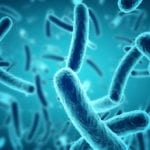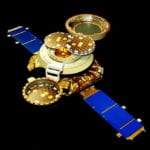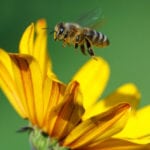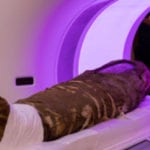 Our World
Our World  Our World
Our World  Movies and TV
Movies and TV The 10 Coolest Stars to Set Sail on The Love Boat
 History
History 10 Things You Didn’t Know About the American National Anthem
 Technology
Technology Top 10 Everyday Tech Buzzwords That Hide a Darker Past
 Humans
Humans 10 Everyday Human Behaviors That Are Actually Survival Instincts
 Animals
Animals 10 Animals That Humiliated and Harmed Historical Leaders
 History
History 10 Most Influential Protests in Modern History
 Creepy
Creepy 10 More Representations of Death from Myth, Legend, and Folktale
 Technology
Technology 10 Scientific Breakthroughs of 2025 That’ll Change Everything
 Our World
Our World 10 Ways Icelandic Culture Makes Other Countries Look Boring
 Our World
Our World 10 Ways Your Christmas Tree Is More Lit Than You Think
 Movies and TV
Movies and TV The 10 Coolest Stars to Set Sail on The Love Boat
 History
History 10 Things You Didn’t Know About the American National Anthem
Who's Behind Listverse?

Jamie Frater
Head Editor
Jamie founded Listverse due to an insatiable desire to share fascinating, obscure, and bizarre facts. He has been a guest speaker on numerous national radio and television stations and is a five time published author.
More About Us Technology
Technology Top 10 Everyday Tech Buzzwords That Hide a Darker Past
 Humans
Humans 10 Everyday Human Behaviors That Are Actually Survival Instincts
 Animals
Animals 10 Animals That Humiliated and Harmed Historical Leaders
 History
History 10 Most Influential Protests in Modern History
 Creepy
Creepy 10 More Representations of Death from Myth, Legend, and Folktale
 Technology
Technology 10 Scientific Breakthroughs of 2025 That’ll Change Everything
 Our World
Our World 10 Ways Icelandic Culture Makes Other Countries Look Boring
10 Bizarre Scientific Art Projects
People tend to divide the population into two categories: the analytical, sciencey types and the freethinking, artistic folks. However, real life isn’t that clear cut. Be it biology, technology, or meteorology, there are plenty of artists out there who express themselves through science. And some of them are pretty weird.
10 The Meteorite That’s Going Back To Space
Around 5,000 years ago, a cluster of iron meteorites tore through the atmosphere and smashed into the Earth, just a little outside Buenos Aires, Argentina. Known as Campo del Cielo (“Field of the Sky”), the rocks remained lodged in the ground for millennia. Occasionally, natives used the metal to forge weapons, and for a while, the Spanish dug around the area hoping to find a vein of iron. Eventually, one of the rocks ended up in the hands of Scottish artist Katie Paterson.
Named “Campo del Cielo, Field of the Sky,” Paterson’s project involved melting the misshapen meteorite, pouring the fiery matter into a mold, and letting it harden into a new form, one probably closer to its original shape. Weighing 110 kilograms (240 lb), the rock went on display at Selfridges London.
But Paterson isn’t through with the meteorite yet. Phase two involves launching the rock back into space.
With the help of the European Space Agency, Paterson plans on sending the meteorite back into the stars aboard a cargo-carrying spacecraft. It’s a largely symbolic gesture that Paterson hopes will stir up the next generation of astronomers and cause people to think about the origins of life, the universe, and everything. That’s a lot of pressure on one little rock.
9 Indoor Clouds
Clouds have always captivated people. Who hasn’t spent a few minutes searching the sky for puffy castles or fluffy elephants? Artists are especially keen on capturing clouds on canvas. Just check out paintings like Munch’s “The Scream” or Homer’s “Eight Bells.” However, Berndnaut Smilde might be the first to create his own clouds. The Dutch artist does away with paintbrushes and instead totally relies on science to produce his real-life portraits.
Starting in 2012, Smilde has traveled the globe, searching for churches and galleries in which to perform his meteorological magic. Once he finds the perfect setting, he lugs in his machinery and starts setting up. For his project to work, the room has to be “acclimatized,” and Smilde spends several days adjusting the temperature and regulating the humidity, spraying the floor and air with water. When it’s time to perform, he fires fog from a machine, which creates an indoor cloud.
While Smilde’s creations are always some variety of cumulus, some are heavy while others are more ethereal. Either way, they only last for a few seconds, giving the artist a short window in which to photograph his work. Ultimately, while there’s a great deal of science involved, Smilde is more “interested in the ephemeral aspect of the work.” It’s there for a moment, and then it’s gone.
8‘Blue Shift’
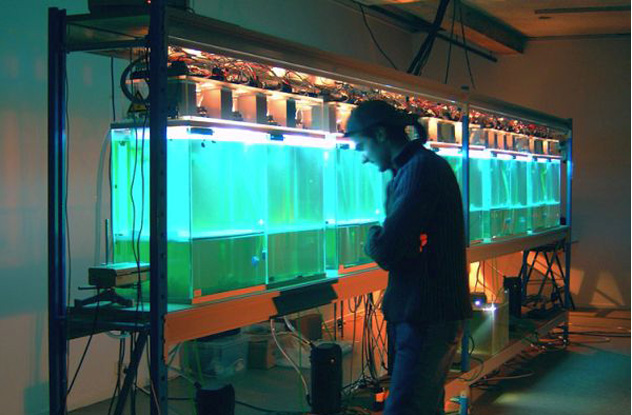
The great theologian Gozer the Gozerian once asked, “Are you a god?” Even though you should say “yes,” chances are good that you’re not. However, art fans who visited Angelo Vermeulen’s “Blue Shift” in 2005 had a chance to flex their omnipotent muscles and show off their divine powers. Not only did the interactive installation give guests control over life and death, it also gave them power over creation.
Teaming up with evolutionary biologist Luc De Meester, Vermeulen rigged up a series of aquariums, complete with hungry fish and anxious water fleas. The tanks were divided horizontally with a plank, but the divider was full of holes. They were small enough to keep the fish on the bottom but large enough so the crustacean fleas could swim back and forth. Of course, any water flea with half a brain would know better than to pal around with a school of fish, right? Well, that all depends on the lighting.
Above the aquariums were a group of spotlights hooked up to a motion sensor. Most of the time, the lights were bright yellow, and that was just fine with the fleas. These little guys are attracted to yellow and swam around the top of the aquarium, trying to get as close to the light as possible. However, water fleas aren’t fond of blue. It signifies open water, and that means the fleas are exposed to predators. So whenever a guest approached the aquarium, the yellow light would change to blue, sending the fleas panicking straight to the bottom of the aquarium. This meant that whenever someone looked at the exhibition, they were sending the crustaceans down to their doom.
However, something else was going on here. A few of the water fleas eventually figured out what was going on and stopped retreating to the bottom. They overcame their natural fear of blue light and avoided ending up as seafood. It was microevolution in action, adaptation in a box, and exactly what Vermuelen wanted to see.
Of course, “Blue Shift” raises a few interesting questions like whether it’s okay to kill in the name of art, but the fish were probably cool with it.
7 Growing Clothes From Bacteria
Tired of spending all your time shopping? Buy a couple of bottles of Kombucha, and grow your own.
Okay, that’s a bit of an oversimplification, but fashion designer Suzanne Lee has been doing something similar for years. With the help of a few million microbes, the director of BioCouture Research Project has created an entire line of jackets, shirts, and shoes.
Before Lee’s dresses are ready for sale, she first brews 30 liters (8 gal) of green tea, making sure to add plenty of sugar. After it cools, Lee adds a mix of bacteria and yeast, little sweet-toothed microbes that feed on the sugary concoction. As the liquid ferments, the creatures produce nanofibers of cellulose, which form a sticky sheet on the top of the bath. After a couple of weeks, Lee skims off an inch-thick worth of growth, which she washes and dries before she starts designing.
The texture of Lee’s creations depends on what recipe she uses. Some of her pieces have a light, papery feel, while others are thicker and more leathery. After she cuts the material or wraps it around a 3-D shape, the threads meld together and form something you might wear to a microbiological ball.
Lee hopes to take the process further one day by actually making clothes out of the microbes themselves. She dreams of living clothing that can nourish the body and even protect people from sickness.
6 Faces Made From DNA
Unless they’ve just stepped on some, most people ignore the wads of gum stuck to the sidewalk. Not Heather Dewey-Hagborg, though. She spends her days searching the streets for masticated Juicy Fruit, strands of hair, and cigarette butts, the fresher the better. Dewey-Hagborg uses these icky clues to get a glimpse of strangers’ faces. The key is in the DNA.
Ask any criminal behind bars—you leave DNA wherever you go. Anytime you toss a smoke or shed a hair, you’re leaving behind clues to your identity, clues Dewey-Hagborg takes to a Brooklyn biotechnology lab called Genspace. Once there, she extracts the DNA, sequences (like the regions that code for traits like sex, hair color, facial dimensions, and likelihood of obesity) and punches the data into a computer program. Afterward, she creates a picture of what the smoker or gum chewer might look like. Of course, the faces aren’t picture perfect copies, but Dewey-Hagborg describes them as having a “family resemblance.”
Since the New York artist can’t determine age, she makes all her models look about 30. After she finishes a portrait, she prints it with a 3-D printer and, voila, she’s taken a photo without a camera.
Named “Stranger Visions,” the project is an amazing example of how technologically advanced we’ve become. In fact, there might be uses for Dewey-Hagborg’s program outside the realm of art. A medical examiner once asked her to use her project to help identify an unknown corpse.
On the other hand, there are plenty of creepy implications as well. If Dewey-Hagborg can create an image of a total stranger, what can the government do? That’s exactly what Dewey-Hagborg wants us to think about. “Stranger Visions” is meant to stir up questions about privacy and surveillance. One thing’s for sure: It’ll make people think twice before littering.
5 The Human Petunia

Eduardo Kac (pronounced “Katz”) might not look like the stereotypical mad scientist, but don’t let physical appearances fool you. This Brazilian-born artist is best known for his “transgenic art,” works that alter nature and create new life forms. Take his controversial “GFP Bunny” for example. With the help of a French scientist, Kac extracted a fluorescent protein from a crystal jellyfish, a creature that glows in the dark. Kac then put the protein in a rabbit egg, and in 2009, Alba the bioluminescent bunny was born. Whenever the little guy hopped under a black light, it would glow green. Sure, his project angered certain animal rights groups, but their outcries didn’t stop from him creating another unusual hybrid.
In 2009, Kac introduced the world to Edunia, a pink petunia that was part human. The highlight of his work entitled “Natural History of the Enigma,” the flower contained genes taken out of Kac’s own body. The artist had scientists draw his blood, copy a genetic sequence from his immune system, and inject the gene into the plant.
The immune system distinguishes between the body and external threats, so adding a blood gene to the petunia symbolically gives Edunia a sense of self. What’s even eerier is that the petunia is full of red veins, drawing parallels to our own blood vessels. Kac dubbed his creation a “plantimal” and proudly put it on display in the Weisman Art Museum in Minneapolis.
“It lives,” he declared. “It is real, as real as you and I. Except nature didn’t make it, I did.” Let’s just hope the good doctor’s monster doesn’t become sentient and go all Little Shop of Horrors on us.
4 Edible Opera
Let’s be honest. Not everyone is a fan of opera. But if you don’t like the sound of opera, you might still enjoy the way it tastes.
London-based artists Michael Burton and Michiko Nitta (“Burton Nitta”), have found a way to capture an opera singer’s voice and turn it into a crazy culinary experience. Instead of using pots and pans, Burton and Nitta have devised the Algraculture, a sci-fi suit made of tubes that wind around the wearer’s body and end up in the mouth. And in this case, the wearer just so happened to be Louise Ashcroft, a mezzo-soprano with a particularly powerful voice.
Whenever Ashcroft belts a tune, she releases carbon dioxide that travels down the tubes and ends up nourishing a colony of algae deep inside the suit. With the help of some fast-acting fertilizer, the eukaryotes feed on the CO2, and by the end of Ashcroft’s performances, they’re healthy, delicious, and ready to eat. Not only does her breath play a vital role, but Ashcroft’s pitch and frequency actually affect the algae’s color, texture, and taste. Depending on how she sings, the organisms might end up sweet or bitter.
The “Algae Opera” might not be everyone’s cup of tea, musically speaking, but it’s definitely a new way to experience culture.
3 Cheese Made From Human Bacteria
Ever taken a whiff of Limburger cheese? You might say it smells like sweaty feet, but really, that’s not too surprising. After all, the bacteria responsible for foot odor is related to the stuff used to make Limburger. In fact, many cheeses like Parmesan and American cheddar are created with “lactobacillus,” the same stuff growing in our digestive, urinary, and genital systems. Microbiologist Christina Agapakis and scent expert Sissel Tolaas just decided to take things a little further.
Armed with cotton swabs, Agapakis and Tolaas swiped various parts of people’s bodies. They dabbed someone’s nose, scrubbed inside a mouth, probed into a belly button, mopped up a few tears, and even swabbed a toe or two. Next, they added the organisms to fresh milk and created eleven cheeses, all of which had the distinct smell of their donors. Unfortunately for fearless foodies, these cheeses weren’t for eating. Instead, they were displayed at the “Grow Your Own . . . Life After Nature” exhibition at the Science Gallery in Dublin, a show which closed earlier this year.
Titled “Selfmade,” the project was supposed to help people better understand microbes. It was also supposed to make people pause and think about why they were so grossed out. “Why are we more uncomfortable,” Agapakis asked, “with the bacteria on the body than we are with bacteria in cheese?”
2 The Man With A Third Ear
Australian artist Stelarc doesn’t need a canvas. He just uses his body. Since the ‘70s, Stelarc has hung himself in the air with metal hooks, ridden around on a giant robot, stuck a camera into his stomach, and even hooked himself up to the Internet. But none of that is quite as weird as Stelarc’s latest anatomical alteration, an experiment so weird it’d make Frankenstein gag.
Entitled “Ear On Arm,” this bizarre project is exactly what it sounds like. Using Stelarc’s own skin, doctors constructed a “biocompatible scaffold” in the shape of an ear. In 2006, they surgically inserted the structure into his left forearm, providing him with an unfinished third ear. As you might imagine, Stelarc’s new organ receives a lot of attention, ranging from curiosity to total disgust. However, the artist isn’t finished yet and plans on having several more surgeries to enhance the organ and give it an ear lobe.
The final step involves rigging the ear with a microphone and wireless transmitter. Stelarc aims to hook up the ear to the Internet so anyone in the world can hear what he’s listening to. He even plans to build it in such a way that if anyone calls him on their phone, he can talk to them through his ear. He’ll hear their voice inside his head thanks to a speaker implanted inside his mouth. Whatever your opinion is on Stelarc, you can’t say the man isn’t dedicated to his art.
1 Giving Birth To A Shark
Japanese artist Ai Hasegawa was facing a dual dilemma. Firstly, she wanted to give birth but firmly believes too many people clutter the planet already. Secondly, she worries about the environment but loves eating endangered animals. While most people would view these problems as totally separate issues, Hasegawa decided to kill two birds with one very weird stone. She’d give birth to a shark.
Hasegawa has looked at the possibilities of birthing dolphins or tuna, and her most recent plan is to carry a spiny dogfish to term. Why did she happen to pick a shark? Well, in her own words, “They’re endangered, their lifespan is almost as long as that of a human, and most importantly, they’re delicious.”
After delivery, Hasegawa would raise the shark before eventually releasing it into the wild. She believes the fish would need to spend some time in the ocean before regaining its savory flavor. However, the shark would be implanted with a GPS device so when someone catches it, Hasegawa could track it down, buy a few filets and eat her own “kid.”
More than a few kinks stand in the way in Hasegawa’s plan, the most notable being that it’s impossible for humans to give birth to sharks. But the Japanese mom-to-be thinks she has most of the wrinkles ironed out. She’s currently working with a gynecologist to enlarge the human womb and convert it into kind of an aquarium. She also plans on creating a genetically altered “shark-human” placenta to keep the pup safe from attacking antibodies. Finally, she believes the perfect shark-mom should be someone who’s rich, single, and menopausal. That way, they won’t have to take any unpleasant medications to stop menstruating. Also: They have to like sharks.
Other than sounding totally insane, Hasegawa’s project raises an interesting question. If, somehow, a woman did deliver an animal, how would she feel about eating it? Hasegawa thinks most people wouldn’t have any trouble scarfing down their own spawn. After all, it happens in nature every day.
Nolan Moore would definitely try a piece of that cheese, but he’ll pass on the shark, thank you very much. You can friend/follow Nolan on Facebook, or you can drop him a line here.
